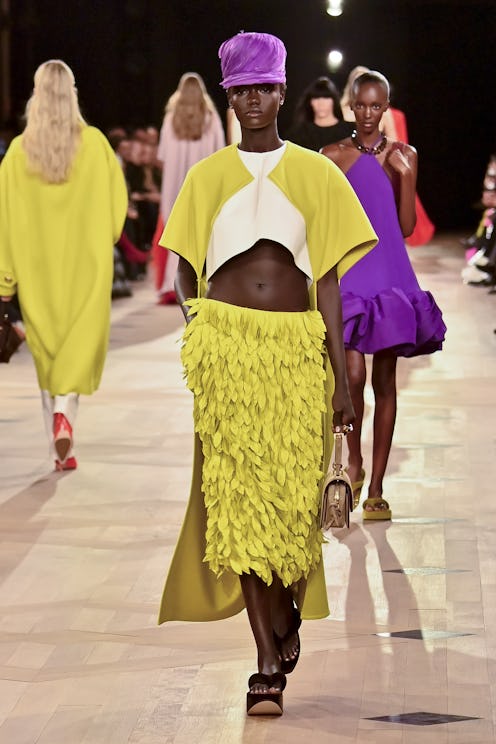(Designers)
Balenciaga’s Spring/Summer 2026 Show’s Was All About Innovation
Pierpaolo Piccioli made a splash.

Following in the footsteps of countless other iconic houses this Spring/Summer 2026 season, Balenciaga has ushered a new era under the creative direction of Pierpaolo Piccioli. The Valentino alum, known for his romantic design and penchant for dramatic proportion and flowing fabric, is coming on the heels of the radically modern and notoriously edgy Demna (who has since moved on to Gucci), so to say all eyes were on the Spanish brand’s latest offering would be a gross understatement. Would Piccioli pick up in the subversive, disruptive, proportion-defying style that Demna left off? Or would he fully embrace the elegant, fanciful aesthetic he built his name on?
Attendees of Balenciaga’s Oct. 4 would find that the answer would lie somewhere in-between. Yes, remnants of Demna’s defiant reign were seen in the futuristic butterfly sunglasses and platform flip-flops. But an undeniable classic sophistication dominated in the floor-sweeping ball skirts, sweeping gowns, and tailored pea coats. As it were, in drawing inspiration for his highly anticipated debut, Piccioli pulled from Cristóbal Balenciaga himself, “recalibrating” the designer’s “aesthetic austerity” and exploration of weightlessness in clothing.
“Recollection rather than tribute, shadows of Balenciaga’s architectonic shapes are embedded in the actuality of today-bold and disruptive volumes applied to clothes that define our modern wardrobe,” read the official show notes. “Leather jackets, chinos, t-shirts, knits, accessories. A vocabulary of contemporaneity, entirely transformed through approach.”
Another transformation came by way of the reinvented gazar fabric, originally invented by Balenciaga (in collaboration with Gustave Zumsteg) in 1958. The material is comprised of “double-face fabric, woven with two warps and two wefts — two textiles, becoming a single entity,” based with a layer of gauze and reinforced with a softer organza on top. The reimagined material, dubbed “neo gazar” enriches the top layer with lamiset (a blend of silk and wool) — the result adds some softness to the somewhat stiff and structural organza, adding more fluidity to the material. The innovation was prominently displayed on the voluminous jewel-toned dresses and skirts, showing off the fabric’s movement. Yet another example of Piccioli’s reverence for the past while simultaneously looking to the future.
Ahead, see the designer’s romantic new vision for Balenciaga.